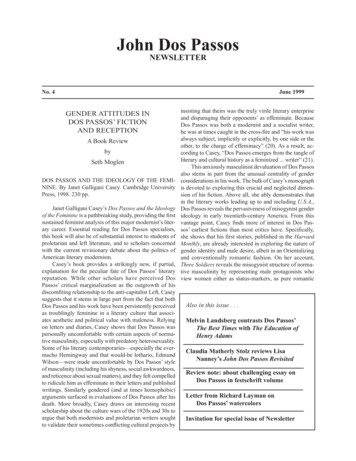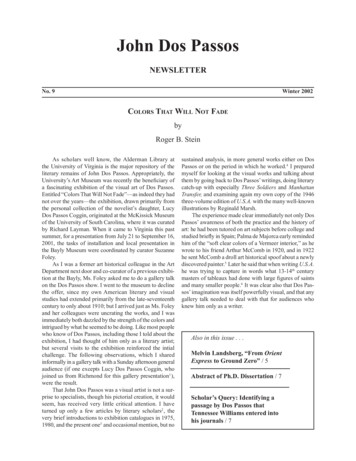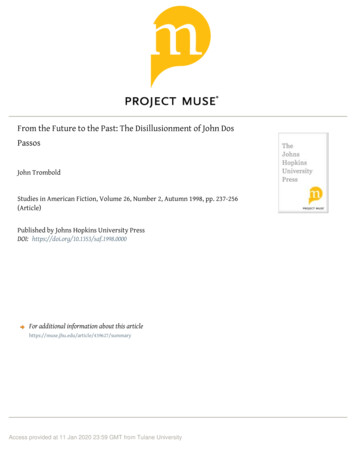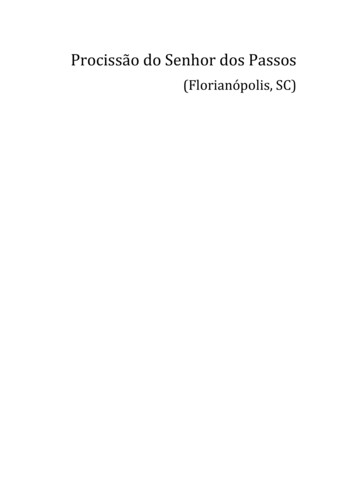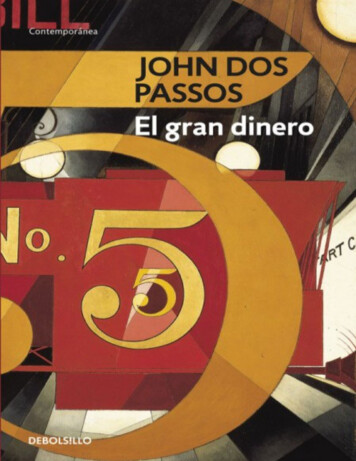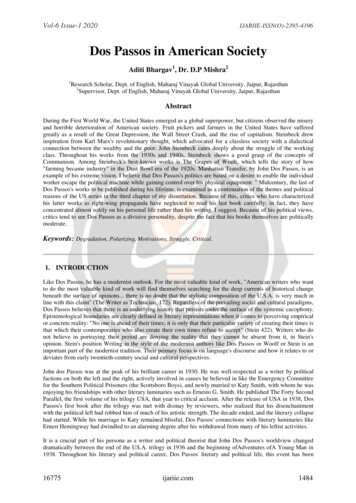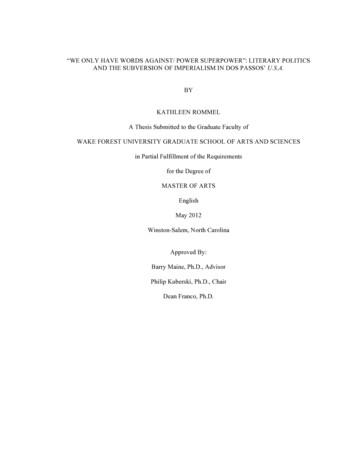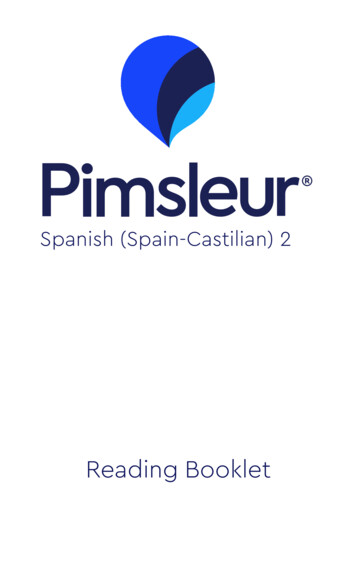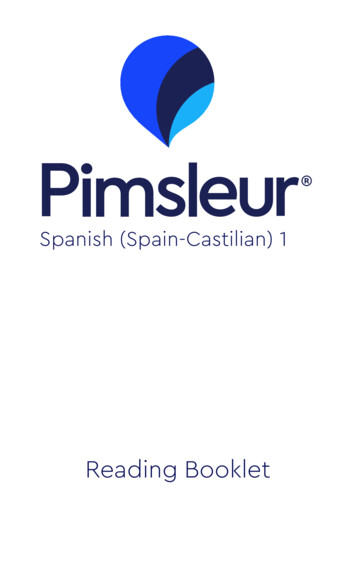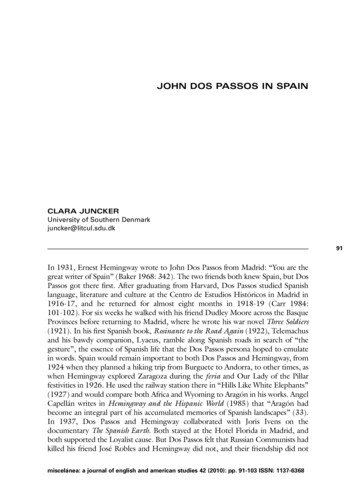
Transcription
JOHN DOS PASSOS IN SPAINCLARA JUNCKERUniversity of Southern Denmarkjuncker@litcul.sdu.dk91In 1931, Ernest Hemingway wrote to John Dos Passos from Madrid: “You are thegreat writer of Spain” (Baker 1968: 342). The two friends both knew Spain, but DosPassos got there first. After graduating from Harvard, Dos Passos studied Spanishlanguage, literature and culture at the Centro de Estudios Históricos in Madrid in1916-17, and he returned for almost eight months in 1918-19 (Carr 1984:101-102). For six weeks he walked with his friend Dudley Moore across the BasqueProvinces before returning to Madrid, where he wrote his war novel Three Soldiers(1921). In his first Spanish book, Rosinante to the Road Again (1922), Telemachusand his bawdy companion, Lyaeus, ramble along Spanish roads in search of “thegesture”, the essence of Spanish life that the Dos Passos persona hoped to emulatein words. Spain would remain important to both Dos Passos and Hemingway, from1924 when they planned a hiking trip from Burguete to Andorra, to other times, aswhen Hemingway explored Zaragoza during the feria and Our Lady of the Pillarfestivities in 1926. He used the railway station there in “Hills Like White Elephants”(1927) and would compare both Africa and Wyoming to Aragón in his works. AngelCapellán writes in Hemingway and the Hispanic World (1985) that “Aragón hadbecome an integral part of his accumulated memories of Spanish landscapes” (33).In 1937, Dos Passos and Hemingway collaborated with Joris Ivens on thedocumentary The Spanish Earth. Both stayed at the Hotel Florida in Madrid, andboth supported the Loyalist cause. But Dos Passos felt that Russian Communists hadkilled his friend José Robles and Hemingway did not, and their friendship did notmiscelánea: a journal of english and american studies 42 (2010): pp. 91-103 ISSN: 1137-6368
Clara Junckersurvive the conflict, or their differing ideas about themes and sequences in Ivens’sfilm (Pizer 1986: 115-116; Ludington 1980: 365-374; Donaldson 1985: 176-177;Capellán 247-248). Dos Passos exorcised Spanish ghosts in the novel Adventures ofa Young Man (1938) and another travel narrative, Journeys Between Wars (1938).Both the exuberant Dos Passos of Rosinante and the angrier author of Journeys enjoythe Spanish people, the land, and the villages, and both present a multicultural andmultiregional Spain, at odds with efforts at centralization and unification.92Dos Passos and Hemingway’s travels in Europe have intrigued generations ofcritics. On Spanish ground, Pilar Marín Madrazo explores in La Gran Guerra enla obra de Hemingway y Dos Passos (1980) their first encounter with war and itsliterary significance, while Catalina Montes in La visión de España en la obra de JohnDos Passos (1980) focuses on Dos Passos and his representation of Spain.Regrettably, these works were largely ignored by Anglo-American critics in the1980s, when Townsend Lundington, Donald Pizer, Scott Donaldson, and otherswrote about the Spanish sojourns of the two expatriate writers. In the 21st Century,Dos Passos and Hemingway in Spain have stimulated critics and writers on bothsides of the Atlantic, who attempt to explain their break-up, to understand theirpolitics, or, in the case of Ignacio Martínez de Pisón, to imagine their world.Understandably, Dos Passos critics find the Spanish Civil War and its personal andpolitical conflicts so compelling that they have not fully explained the aestheticramifications of his Spanish experiences. In Rosinante, Spain becomes a testingground for aesthetic experiments, as the young author searches for techniques toarticulate his resistance to American systems and narratives. The Spanish gesturecommunicates both aesthetic and political choices and links up with themasculinity that Dos Passos associates with opposition and pride. In hisnon-fiction from the Second Republic, the author of U.S.A. focuses on Spanishpolitics, but he articulates his own political stance most subtly through form. Apartfrom his modernist interventions, the older Dos Passos satirizes both Nationalistsand Republicans, who subscribe to measures and stories he could not decipher buthoped to deconstruct.Like his alter ego Telemachus, Dos Passos tries in Rosinante to locate a gesture thatin terms of Spain says it all. “I can’t help it. [.] I must catch that gesture, formulateit, do it”, Telemachus exclaims to Lyaeus. He is in Spain for this reason: “It’sburned into my blood. It must be formulated, made permanent” (Dos Passos1922: 20). The young traveler traces the gesture in Pastora Imperio’s flamencodance, which represents the Spain he hopes to capture in words. Blood frozen withanticipation, he watches Pandora come on stage:Her face is brown, with a pointed chin; her eyebrows that nearly meet over her noserise in a flattened “A” toward the fervid black gleam of her hair; her lips are pursedin a half-smile as if she were stifling a secret. She walks round the stage slowly, onemiscelánea: a journal of english and american studies 42 (2010): pp. 91-103 ISSN: 1137-6368
John Dos Passos in Spainhand at her waist, the shawl tight over her elbow, her thighs lithe and restless, apanther in a cage. At the back of the stage she turns suddenly, advances; the snappingof her fingers gets loud, insistent; a thrill whirrs through the guitar like a covey ofpartridges scared in a field. Red heels tap threateningly. (Dos Passos 1922: 14-15)In lo flamenco, Pandora erases boundaries between life and death, pleasure andterror, body and mind. She is frightening, nurturing and defiant, the perfectembodiment of Dos Passos’s artistic vision: “That gesture, a yellow flame againstmaroon and purple cadences [.,] an instant swagger of defiance in the midst of alitany to death the all-powerful. That is Spain”. Then he corrects himself: “.Castile at any rate” (Dos Passos 1922: 17). With the three dots preceding“Castile”, Dos Passos expresses Pandora’s ability to bridge the national and theregional, as well as the general and the individual, a balance he himself hoped tostrike in his portrait of Spain and in his fiction generally. The ellipsis hides as wellhis own ambivalence, as he vacillates between anarchistic, individual tendencies andthe desire for truth and essence that drives him across Spanish terrain. His art must,like Pandora’s, combine danger and healing. It must scare its audience and thenoffer comfort, “as a nurse might look into the eyes of a child she hasunintentionally frightened with a too dreadful fairy story” (Dos Passos 1922: 15).It must, in short, escape established systems and categories.Spain lends itself to his artistic vision through its lack of unity and organization.As Telemachus watches shadows striped with moonlight in Motril, he contemplatesthe “bewildering dazzle of the night” and watches three “disconnected mules”jingling out of the shadow in the plaza (Dos Passos 1922: 31). Later, inside thestagecoach, he watches “the mules that roamed drunkenly from side to side of theuneven road” (Dos Passos 1922: 32). Spain becomes an aesthetic discoursestressing asymmetry and disjunction, and Dos Passos identifies difference as ageneral principle in Spanish art. In El Greco, Goya, Zuloaga and others who havesuccessfully painted the peculiar and the picturesque of Spanish faces and Spanishlandscapes, Dos Passos sees a “powerful sense of the separateness of things”. Ona topic close to his heart and his literary production, Dos Passos notes aboutSpanish art that it verges on caricature in order to differentiate among individuals.“Given the ebullient fertility of the Spanish mind and its intense individualism”,he writes, “a constant slipping over into the grotesque is inevitable” (Dos Passos1922: 58).Dos Passos clarifies his aesthetic preferences through the picaresque form ofRosinante, which emphasizes fragmentation and non-closure. As modern-daypicaros, Telemachus and Lyaeus travel across the Iberian Peninsula, their journeydotted with passers-by, talks by the road, and introductions to Spanish writers andeducators. Dos Passos does not construct a coherent narrative or a coherent Spain,but he presents an aesthetic vision that led to U.S.A. In his famous trilogy, hemiscelánea: a journal of english and american studies 42 (2010): pp. 91-103 ISSN: 1137-636893
Clara Junckerbegins and ends his American epic with Vag, the traveller-observer who listens tothe “speech of the people” as he keeps moving “a hundred miles down the road”(Dos Passos 1937: 3, 1240).94In U.S.A. Dos Passos dots his epic of American dreams and disillusions withbiographies of famous Americans who had given the nation its contours. By thenhe had studied Diego Rivera’s paintings in the courts of the Secretariat of publiceducation in Mexico City and had learned to paint social criticism withrepresentative figures and words (Dos Passos 1927: 15). In Rosinante, the authoralso interrupts his travel narrative with short biographies of important Spaniards,who serve as role models, or the opposite, to the author-traveller. A Spanish poemabout death inspires a journey into the past, where Don Jorge is mourning hisfather, the Master of Santiago. Telemachus introduces the poet sitting underneatha lemon tree, in the court of his “dust-colored” mansion, a myriad of detailsfleshing out this biographical sketch and halting his own journey across Spain: asuit of black velvet, pigeons cooing, vermilion arabesques, the catafalque of theMaster of Santiago, and the waiting bishop impatiently fingering his crosier (DosPassos 1922: 11). Because of his aesthetic mission in Rosinante, Dos Passos prefersto portray writers, scholars and artists. Another biographical intermezzo focuses onPío Baroja, a “novelist of revolution” (Dos Passos 1922: 80), who obviouslyinspires both Telemachus and his author. Having practiced medicine without “thecocksure brutality of a country doctor”, Baroja opened a bakery and began to writeinstead (Dos Passos 1922: 82). As in his U.S.A trilogy, Dos Passos wraps up hisshort biography with an evaluation of Baroja’s life and worth: “So, by meetingcommerce squarely in its own field, he has freed himself from any compromise withMammon. While his bread remains sweet, his novels may be as bitter as he likes”(Dos Passos 1922: 83). In the portraits of both Don Jorge and Pío Baroja, DosPassos pays tribute to the individualist aesthetics of resistance that he himself wouldadopt.In passing through this or that village, Telemachus experiences both the strength andthe weakness of the Spain he visits in 1922. “This intense individualism”, Dos Passoswrites, “born of a history whose fundamentals lie in isolated village communities—pueblos, as the Spaniards call them— over the changeless face of which, like grassover a field, events spring and mature and die, is the basic fact of Spanish life. Norevolution has been strong enough to shake it” (Dos Passos 1922: 53). His wordsconjure up a historical and natural Spain and present his conception of “thechangeless Iberian mind”, but he resists a national story or history. The country, hefinds, is “essentially centrifugal”, with centralized government resulting in what hecalls “the present atrophy, the desolating resultlessness of a century of revolution”.“Iberia exists”, he asserts, “but Spain as a modern centralized nation is an illusion”(Dos Passos 1922: 53, 55). Instead, he argues for variety and multiplicity:miscelánea: a journal of english and american studies 42 (2010): pp. 91-103 ISSN: 1137-6368
John Dos Passos in SpainIn trying to hammer some sort of unified impression out of the scattered picturesof Spain in my mind, one of the first things I realize is that there are many Spains.Indeed, every village hidden in the folds of the great barren hills, or shadowed byits massive church in the middle of one of the upland plains, every fertile huerta ofthe seacoast, is a Spain. (Dos Passos 1922: 55)To support his argument, Dos Passos mentions first the linguistic diversity of theSpain he encounters, where he identifies “four distinct languages” (Dos Passos1922: 55-56). He emphasizes as well the varied topography of the Iberian Peninsula,which he compares to locations across the globe. The central plateaux that havedominated traditional modern history resemble Russian steppes in terms of climateand vegetation; the west coast is a luckier Wales. The southern huertas or “arableriver valleys” look like Egypt, while the east coast north of Valencia appears as acontinuation of coastal Mediterranean France. “In this country”, he concludes,“where an hour’s train ride will take you from Siberian snow into African desert,unity of population is hardly to be expected” (Dos Passos 1922: 57).Dos Passos ascribes Spanish pride and religion to intense individualism. A proudIberian trusts nothing outside the self and moves, like El Greco, towards a “restless,almost sensual spirituality in forms that flickered like white flames toward God”.For the Spaniard, he concludes, “God is always, in essence, the proudestsublimation of a man’s soul” (Dos Passos 1922: 60). In this “hunger ofimmortality”, Dos Passos finds “the core of the individualism that lurks in allSpanish ideas, the conviction that only the individual soul is real” (Dos Passos1922: 61). In his view, persistent attempts to unify or centralize —in art,government, philosophy or religion— have resulted in a deadlock, since Spanishenergy moves in the opposite direction. Dos Passos sums up the choices facing thecountry:The problem of our day is whether Spaniards evolving locally, anarchically, withoutcentralization in anything but repression, will work out new ways of life forthemselves, or whether they will be drawn into the festering tumult of a Europewhere the system that is dying is only strong enough to kill in its death-throes allnew growth in which there was hope for the future. The Pyrenees are high. (DosPassos 1922: 65)Dos Passos’s optimism appears not just in his line about the Pyrenees or in hisyouthful delight with the Spanish people and places of his journey, or in his journeyas such. He is on the move, like the young Spanish men eager for love andadventure or the Spanish artists who give Spanish art its “strangely impromptucharacter”. Like the mature Dos Passos, the author of Rosinante links art andpolitics directly. “Perhaps the strong sense of individual validity, which makes Spainthe most democratic country in Europe, sanctions the constant improvisation, andaccounts for the confident planlessness as common in Spanish architecture as inmiscelánea: a journal of english and american studies 42 (2010): pp. 91-103 ISSN: 1137-636895
Clara JunckerSpanish political thought” (Dos Passos 1922: 59-60). The famous author of theU.S.A. trilogy, who called himself an “architect of history”, is waiting beyond thehorizon.96By inhabiting the character of Telemachus, Dos Passos suggests that manhood alsoawaits him in Spain. Born on the day Odysseus departed for the Trojan War,Telemachus grows up in the company of his mother Penelope and a nurse, withouta masculine role model. He bursts into tears in front of the people of Ithaca andis sent off in search of his father by Athena, disguised as Mentor. This quest formasculinity opens Rosinante, though Dos Passos stresses that Telemachus nolonger remembers what he is looking for, in Spain or elsewhere (Dos Passos 1922:9). His search for “the gesture” nonetheless takes him to masculine spaces, like thecafé and bar where Telemachus and Lyaeus find themselves amidst “whiskered menleaning over tables, astride chairs, talking”. With the proximity of masculine bodies,Telemachus intuitively remembers his quest. He responds to Lyaeus who has askedwhy he is in Spain: “It’s the gesture that’s so overpowering; don’t you feel it inyour arms? Something sudden and tremendously muscular” (Dos Passos 1922: 17).Lyaeus brings up bullfighting to bolster the masculinity they both desire, includingthe association between manhood and death that also Hemingway would stress(Dos Passos 1922: 17).Dos Passos links this pursuit of manhood with his search for aesthetic forms. Ashis mouthpiece Telemachus recollects the dancing Pastora, the memory turnssexual. The “strong modulations” of the flamenco-dancer, Dos Passos writes,“seemed burned in his flesh. He drew a deep breath. His body tightened like acatapult. ‘Oh, to recapture that gesture,’ he muttered” (Dos Passos 1922: 19).Through his art, young Dos Passos hoped to prove himself a man. LikeTelemachus, he had spent too much time in the company of his mother and hisnurses and was ready to strike out on his own. In the U.S.A. trilogy, his vision ofmanhood would link sexuality with aesthetics and politics: the working-class boysand men get closer to the Revolution than the upper-class author of theautobiographical Camera Eye segments. In Rosinante, Telemachus idealizes themanly peasants who are anarchists during the day and lovers at night. AsTelemachus travels on by coach, the languid driver Paco, the erratic movementsof the coach, the uneven road, and the memory of the tavern make up the eroticand political landscape of Andalusia: “As the coach jangled its lumbering unsteadyway out of town, our ears still throbbed with the rhythm of the tavern, of hardbrown hands clapped in time, of heels thumping on oak floors” (Dos Passos 1922:34-35). By capturing the gesture of Spain, Dos Passos hoped to write himself intomanly action. But his vision retains the homo-social or homo-erotic undertonesthat critics identify in the Hemingway canon. At the end of Rosinante,Telemachus and Lyaeus have become mirror images united by jokes and wetmiscelánea: a journal of english and american studies 42 (2010): pp. 91-103 ISSN: 1137-6368
John Dos Passos in Spainbodies, while a young Spanish girl remains safely upstairs, a vehicle for the youngmen’s bonding only.Fifteen years later, in 1937, Dos Passos was approaching the Spanish border as aforeign correspondent and as Hemingway’s collaborator on The Spanish Earthdocumentary. The famous author of U.S.A. was now less exuberant, if notdownright disillusioned. Jorge Luis Borges writes about Dos Passos that hisimportance is incontestable, but he finds that U.S.A. leaves “a final impression ofsadness and futility since it suffers from a lack of passion and faith” (Borges 1971:48). Outside a café at Cerbère, this disheartened author watched with a crowd ofold men and a sad-faced woman a distant airplane flying low towards Spain.“Loyalist? Fascist?” they all wonder, as the plane disappeared over the horizon,behind a cemetery (Dos Passos 1938: 348). The beer at the café is flat and sourand, with the disappearing plane, the graveyard and the woman in black, it turnsinto an omen for his disastrous trip. Journeys Between Wars opens with reprintedsections from Rosinante and closes with Dos Passos in Civil War Spain and thuslinks his separate Spanish experiences with his Orient Express accounts bridging thetime gap. Once again his form highlights the fragmented and anarchic, as thenarrator moves from Madrid under siege to sections on Hotel Florida, scenes fromcrowded streets and long anxious nights in April 1937, and along narrow ruralroads. In the countryside Dos Passos visits village bakeries, fishing towns, andeventually the P.O.U.M. headquarters in Barcelona. The voices of the young andthe older Dos Passos mingle in their love for Spain and in finding hope for thefuture in village communities off the main road. Spanish writers would alsocombine the personal and the political in their accounts of Civil War Spain, as inArturo Barea’s La forja de un rebelde (1951).In “The Villages Are the Heart of Spain”, Dos Passos describes an energetic youngdoctor unwilling to think of a private life until the Fascists have left Spain. Thedoctor and the author enter a village bakery, where the cozy smell of breadenvelopes the tired travellers, who leave with arms full of the big loaves. Back inthe car, the doctor speaks bitterly of the hunger in Madrid, while Dos Passos findshope in the sweet-smelling bread and the people it nourishes: “country peopleeating their suppers in the dim roomy stone houses and the sharpsmelling herbsin the fires and the brown faces looking out from the shelter of doorways at thebright stripes of the rain in the street and the gleam of the cobbles and the sturdyfigures of countrywomen under their shawls” (Dos Passos 1938: 385). Dos Passosalso shows his faith in the Spanish people in his report from Fuentedueña, a poorvillage transformed into an agrarian collective. He writes at length about thevillagers’ crops, their newly acquired pumping machinery, their irrigation plans, andtheir pride and self-sufficiency. Everybody felt very good about the socialistcommunity, he concludes, “so good that they almost forgot the hollow poppingmiscelánea: a journal of english and american studies 42 (2010): pp. 91-103 ISSN: 1137-636897
Clara Junckerbeyond the hills that they could hear from the Jarama River front fifteen miles away,and the truckload of soldiers and munitions going though the village up the roadto Madrid and the fear they felt whenever they saw an airplane in the sky. Is it oursor theirs?” (Dos Passos 1938: 388). Like the socialist experiment surrounded byfear and death, Dos Passos writes Spanish life and people into fragments andvignettes. His form collides with Nationalist narratives stressing unity andcoherence and the vision of war they promote.98In April 1938 The Nationalists’ newly formed National Spanish State TouristDepartment, headed by Luis Bolín, circulated various tourist brochures to promptforeign visitors and journalists to travel along Rutas Nacionales de Guerra (NationalWar Routes). Early in the war, Bolín had headed the foreign press services at theNationalist headquarters in Salamanca. As the main contact person for foreign warcorrespondents reporting from the front, he had censored news even remotelycritical of Nationalist positions. His brochures now advertised nine-day bus toursto battlefields and other sites of human carnage, a “thanatourism” combining threemeals a day and first-class hotels with real or symbolic encounters with death. Withthis new initiative, Bolín attempted to present the Nationalists as legitimategovernment representatives and upholders of order and tradition in the face ofRepublican chaos and anarchy. To this end, he relied on the “Francoist Crusadenarrative”, in which Nationalists restored God and Catholicism to a Spain in thegrips of lawless Communists. The dominant Nationalist narratives —“the SpanishCivil War as Crusade and the exaltation of Spain’s Catholic and medieval past”—maintained that the Republicans had torn apart Spain’s national unity and itstraditional, legitimate social order (Holguín 2005: 1414-1415). In short, theNationalists were entitled to carry out the military coup that triggered the civil war.Like other politicians, artists, intellectuals and activists siding with the Republic,Dos Passos disputed the idea of a unified Spain and subscribed to the ideas of aplural Spain: “Spanish national identity had its root in liberalism and theEnlightenment, in the belief in individual rights, a constitution, representativegovernment, and the separation of church and state” (Holguín 2005: 1412).Republican sympathizers saw Spanish society as pluralistic; the Spanish nation couldstill be strong, even if Basques and Catalans achieved regional autonomy within theSpanish state. Opponents argued that the Republicans had disregarded Spanishhistory and culture and so they promoted a strong monarchy that cooperated withthe Catholic Church. They viewed Spain as an organic whole, without regionalidentities and platforms and with a well-regulated hierarchical distribution of power(Holguín 2005: 1412ff).Dos Passos hated this Nationalist vision, as he makes clear in a description of KingAlfonso XIII’s sudden departure for London in 1931. In a section from Journeyssigned “Santander, August 1933”, and ironically titled “The Republic of Honestmiscelánea: a journal of english and american studies 42 (2010): pp. 91-103 ISSN: 1137-6368
John Dos Passos in SpainMen”, Dos Passos crams the royal power paraphernalia into a series of descriptionsthat constitute most of the lengthy first sentence of the piece. His anger drips fromthe passage that deserves quoting in full:When Don Alfonso finished sorting out and burning papers in his office on the sideof the palace towards the city, he walked round to the other side of the immensepilastered greystone building; through the tall state rooms ornate with overweeningpomp of scrolling designs in stucco and gilt and bronze and crystal and damask andvelvet; through the throne room with its lions and its crowns and its crowded blackbusts of antique Romans; under the huge ceiling where, for the first of the Bourbonsin the gaudy days of the Sun King, the Venetian Tiepolo had painted, in that dazeof blue empyrean light that was his specialty, the grandiloquently draped abstractionsof Government and Power; under the tasseled portières, through the inlaideighteenth-century doors, to the room where the Englishwoman his wife was havingtea. (Dos Passos 1938: 304)Dos Passos sharpens his satirical scalpel in this enumeration of Don Alfonso’spossessions. The passage climaxes with his ultimate treasure, the tea-sippingEnglishwoman, who resembles Nancibel Taylor in Dos Passos’s Boston novel,Streets of Night (1923) and also signifies upper-class sterility.Dos Passos especially attacks the so-called honest men who built the Republic. Asin U.S.A., he dissects with satire the prominent intellectuals who got up fromtertulias at Madrid cafés to create a Spain they had not envisioned. Indeed, theysurpass Don Alfonso’s regime in terms of brutality and repression. Dos Passosangrily condemns these ruthless academics:How was it that these honest men, lawyers, doctors, socialist professors and lecturers,that finer element of the population that is the dream of reformers the world over toget into positions of power, found themselves so situated that it was easy for them tovote approval of the deportations on the Buenos Aires or the shootings at Casas Viejasas it had been for their ancestors [.] to approve of the stranglings and burnings ofheretics and Jews in the days of good King Philip? (Dos Passos 1938: 313)Dos Passos knows the answer: “Almost to a man they called for jails and Mausers andmachineguns to protect the bureaucracy that was the source of the easy life and thehot milk and the coffee and the Americanmade cars, and order, property,investments”. “They smelt danger”, he writes. “Maybe the new Spain wasn’t theSpain of the Madrid bureaucracy, or the Spain of those who weren’t holding jobs yet:the honest men” (Dos Passos 1938: 314). These honest men speak through theghosts of Casas Viejas, the village where the Civil and Assault Guards in the nameof the Republic carried out a massacre of fourteen or sixteen LibertarianCommunists. In contrast, the highly educated founders of the republic sold theirdreams to protect their comfortable lives and get pinned on Dos Passos’s satirical pen.miscelánea: a journal of english and american studies 42 (2010): pp. 91-103 ISSN: 1137-636899
Clara JunckerIn the U.S.A. trilogy, Dos Passos writes in fragments his distrust of master narrativesand institutions of power, whether left, right, or middle. Like the satirist GeorgeGroz, he sharpens his pen and uses his art against “POWER/SUPERPOWER”.In Journeys, Dos Passos covers a demonstration in Santander, where oily-tonguedSocialist leaders speak vaguely of a workers’ state and more concretely of discipline,moderation, and order. The Socialist folk march by the city cafés, where theirenemies watch them with quiet hatred: “people with gimlet eyes and greedypredatory lines on their faces, jerkwater importers and exporters, small brokers,loan sharks, commission merchants, pawnbrokers, men who knew how to maketwo duros grow where one had grown before”. Dos Passos concludes: “Thesocialistas filed on by as innocent as a flock of sheep in wolf country” (Dos Passos1938: 328, 329). With a rhetoric echoing U.S.A., Dos Passos promotes anindividualist, anarchist or democratic position and opposes centralized powerstructures at both ends of the political spectrum.100As always, Dos Passos trusts the people. On a stroll through Madrid, he visits thetower of Wall Street’s International Tel and Tel, to Dos Passos “the symbol of thecolonizing power of the dollar” (Dos Passos 1938: 366). He describes theapparatus of telecommunication inside the building as a link to countries wagingwars with gold credits and weapon contracts and “conversations on red plush sofasin diplomatic anterooms” and he himself chooses to flee into sunny streets (DosPassos 1938: 367). In Valencia, he finds that art and intellectual life will no longerdo. Newly arrived tapestries from the royal castle in Madrid evoke civil-war Spainwith apocalyptic scenarios of hunger, pestilence and death, but young men in thechapel that holds the treasures turn away with a shrug. Dos Passos himself findsthe converted hotel called the House of Culture dreary and irrelevant. “We feellike old trunks in somebody’s attic”, Dos Passos concludes (Dos Passos 1938: 358).Again, the streets hold the life and the individuals he seeks out: “It’s a relief to getout on the pitchblack streets where there are unrestrained voices, footsteps,giggling, the feeling of men and women walking through the dark with blood intheir veins” (Dos Passos 1938: 359). As in Manhattan Transfer (1925) and theU.S.A. trilogy, Dos Passos is searching for answers among the ordinary people ofhis cityscapes, but he can no longer work out their problems. He focuses on avolunteer who has joined the International Brigade to save Madrid from theFascists, but cannot alleviate his private and political sorrow: “What can he do?What can we do? We tell him
In 1931, Ernest Hemingway wrote to John Dos Passos from Madrid: "You are the great writer of Spain" (Baker 1968: 342). The two friends both knew Spain, but Dos Passos got there first. After graduating from Harvard, Dos Passos studied Spanish language, literature and culture at the Centro de Estudios Históricos in Madrid in
